- Home
- Wendell Berry
Bringing It to the Table: On Farming and Food Page 2
Bringing It to the Table: On Farming and Food Read online
Page 2
Like the farmland, the farm communities are declining and eroding. The farmers who are still farming do not farm with as much skill as they did forty years ago, and there are not nearly so many farmers farming as there were forty years ago. As the old have died, they have not been replaced; as the young come of age, they leave farming or leave the community. And as the land and the people deteriorate, so necessarily must the support system. None of the small rural towns is thriving as it did forty years ago. The proprietors of small businesses give up or die and are not replaced. As the farm trade declines, farm equipment franchises are revoked. The remaining farmers must drive longer and longer distances for machines and parts and repairs.
Looking at the country now, one cannot escape the conclusion that there are no longer enough people on the land to farm it well and to take proper care of it. A further and more ominous conclusion is that there is no longer a considerable number of people knowledgeable enough to look at the country and see that it is not properly cared for—though the face of the country is now everywhere marked by the agony of our enterprise of self-destruction.
And suddenly in this wasting countryside there is talk of raising production quotas on Burley tobacco by 24 percent, and tobacco growers are coming under pressure from the manufacturers to decrease their use of chemicals. Everyone I have talked to is doubtful that we have enough people left in farming to meet the increased demand for either quantity or quality, and doubtful that we still have the barnroom to house the increased acreage. In other words, the demand going up has met the culture coming down. No one can be optimistic about the results.
Tobacco, I know, is not a food, but it comes from the same resources of land and people that food comes from, and this emerging dilemma in the production of tobacco can only foreshadow a similar dilemma in the production of food. At every point in our food economy, present conditions remaining, we must expect to come to a time when demand (for quantity or quality) going up will meet the culture coming down. The fact is that we have nearly destroyed American farming, and in the process have nearly destroyed our country.
How has this happened? It has happened because of the application to farming of far too simple a standard. For many years, as a nation, we have asked our land only to produce, and we have asked our farmers only to produce. We have believed that this single economic standard not only guaranteed good performance but also preserved the ultimate truth and rightness of our aims. We have bought unconditionally the economists’ line that competition and innovation would solve all problems, and that we would finally accomplish a technological end-run around biological reality and the human condition.
Competition and innovation have indeed solved, for the time being, the problem of production. But the solution has been extravagant, thoughtless, and far too expensive. We have been winning, to our inestimable loss, a competition against our own land and our own people. At present, what we have to show for this “victory” is a surplus of food. But this is a surplus achieved by the ruin of its sources, and it has been used, by apologists for our present economy, to disguise the damage by which it was produced. Food, clearly, is the most important economic product—except when there is a surplus. When there is a surplus, according to our present economic assumptions, food is the least important product. The surplus becomes famous as evidence to consumers that they have nothing to worry about, that there is no problem, that present economic assumptions are correct.
But our present economic assumptions are failing in agriculture, and to those having eyes to see the evidence is everywhere, in the cities as well as in the countryside. The singular demand for production has been unable to acknowledge the importance of the sources of production in nature and in human culture. Of course agriculture must be productive; that is a requirement as urgent as it is obvious. But urgent as it is, it is not the first requirement; there are two more requirements equally important and equally urgent. One is that if agriculture is to remain productive, it must preserve the land, and the fertility and ecological health of the land; the land, that is, must be used well. A further requirement, therefore, is that if the land is to be used well, the people who use it must know it well, must be highly motivated to use it well, must know how to use it well, must have time to use it well, and must be able to afford to use it well. Nothing that has happened in the agricultural revolution of the last fifty years has disproved or invalidated these requirements, though everything that has happened has ignored or defied them.
In light of the necessity that the farmland and the farm people should thrive while producing, we can see that the single standard of productivity has failed.
Now we must learn to replace that standard by one that is more comprehensive: the standard of nature. The effort to do this is not new. It was begun early in this century by Liberty Hyde Bailey of the Cornell University College of Agriculture, by F. H. King of the University of Wisconsin College of Agriculture and the United States Department of Agriculture, by J. Russell Smith, professor of economic geography at Columbia University, by the British agricultural scientist Sir Albert Howard, and by others; and it has continued into our own time in the work of such scientists as John Todd, Wes Jackson, and others. The standard of nature is not so simple or so easy a standard as the standard of productivity. The term “nature” is not so definite or stable a concept as the weights and measures of productivity. But we know what we mean when we say that the first settlers in any American place recognized that place’s agricultural potential “by its nature”—that is, by the depth and quality of its soil, the kind and quality of its native vegetation, and so on. And we know what we mean when we say that all too often we have proceeded to ignore the nature of our places in farming them. By returning to “the nature of the place” as standard, we acknowledge the necessary limits of our own intentions. Farming cannot take place except in nature; therefore, if nature does not thrive, farming cannot thrive. But we know too that nature includes us. It is not a place into which we reach from some safe standpoint outside it. We are in it and are a part of it while we use it. If it does not thrive, we cannot thrive. The appropriate measure of farming then is the world’s health and our health, and this is inescapably one measure.
But the oneness of this measure is far different from the singularity of the standard of productivity that we have been using; it is far more complex. One of its concerns, one of the inevitable natural measures, is productivity; but it is also concerned for the health of all the creatures belonging to a given place, from the creatures of the soil and water to the humans and other creatures of the land surface to the birds of the air. The use of nature as measure proposes an atonement between ourselves and our world, between economy and ecology, between the domestic and the wild. Or it proposes a conscious and careful recognition of the interdependence between ourselves and nature that in fact has always existed and, if we are to live, must always exist.
Industrial agriculture, built according to the single standard of productivity, has dealt with nature, including human nature, in the manner of a monologist or an orator. It has not asked for anything, or waited to hear any response. It has told nature what it wanted, and in various clever ways has taken what it wanted. And since it proposed no limit on its wants, exhaustion has been its inevitable and foreseeable result. This, clearly, is a dictatorial or totalitarian form of behavior, and it is as totalitarian in its use of people as it is in its use of nature. Its connections to the world and to humans and the other creatures become more and more abstract, as its economy, its authority, and its power become more and more centralized.
On the other hand, an agriculture using nature, including human nature, as its measure would approach the world in the manner of a conversationalist. It would not impose its vision and its demands upon a world that it conceives of as a stockpile of raw material, inert and indifferent to any use that may be made of it. It would not proceed directly or soon to some supposedly ideal state of things. It would proceed directly and soo
n to serious thought about our condition and our predicament. On all farms, farmers would undertake to know responsibly where they are and to “consult the genius of the place.” They would ask what nature would be doing there if no one were farming there. They would ask what nature would permit them to do there, and what they could do there with the least harm to the place and to their natural and human neighbors. And they would ask what nature would help them to do there. And after each asking, knowing that nature will respond, they would attend carefully to her response. The use of the place would necessarily change, and the response of the place to that use would necessarily change the user. The conversation itself would thus assume a kind of creaturely life, binding the place and its inhabitants together, changing and growing to no end, no final accomplishment, that can be conceived or foreseen.
Farming in this way, though it certainly would proceed by desire, is not visionary in the political or utopian sense. In a conversation, you always expect a reply. And if you honor the other party to the conversation, if you honor the otherness of the other party, you understand that you must not expect always to receive a reply that you foresee or a reply that you will like. A conversation is immitigably two-sided and always to some degree mysterious; it requires faith.
For a long time now we have understood ourselves as traveling toward some sort of industrial paradise, some new Eden conceived and constructed entirely by human ingenuity. And we have thought ourselves free to use and abuse nature in any way that might further this enterprise. Now we face overwhelming evidence that we are not smart enough to recover Eden by assault, and that nature does not tolerate or excuse our abuses. If, in spite of the evidence against us, we are finding it hard to relinquish our old ambition, we are also seeing more clearly every day how that ambition has reduced and enslaved us. We see how everything—the whole world—is belittled by the idea that all creation is moving or ought to move toward an end that some body, some human body, has thought up. To be free of that end and that ambition would be a delightful and precious thing. Once free of it, we might again go about our work and our lives with a seriousness and pleasure denied to us when we merely submit to a fate already determined by gigantic politics, economics, and technology.
Such freedom is implicit in the adoption of nature as the measure of economic life. The reunion of nature and economy proposes a necessary democracy, for neither economy nor nature can be abstract in practice. When we adopt nature as measure, we require practice that is locally knowledgeable. The particular farm, that is, must not be treated as any farm. And the particular knowledge of particular places is beyond the competence of any centralized power or authority. Farming by the measure of nature, which is to say the nature of the particular place, means that farmers must tend farms that they know and love, farms small enough to know and love, using tools and methods that they know and love, in the company of neighbors that they know and love.
In recent years, our society has been required to think again of the issues of use and abuse of human beings. We understand, for instance, that the inability to distinguish between a particular woman and any woman is a condition predisposing to abuse. It is time that we learn to apply the same understanding to our country. The inability to distinguish between a farm and any farm is a condition predisposing to abuse, and abuse has been the result. Rape, indeed, has been the result, and we have seen that we are not exempt from the damage we have inflicted. Now we must think of marriage.
Stupidity in Concentration
(2002)
I. CONFINEMENT, CONCENTRATION, SEPARATION
MY TASK HERE is to show the great stupidity of industrial animal production. Factory farms, like this essay, have the aim of cramming as much as possible into as small a space as possible. To understand these animal factories, we need to keep in mind three principles: confinement, concentration, and separation.
The principle of confinement in so-called animal science is derived from the industrial version of efficiency. The designers of animal factories appear to have had in mind the example of concentration camps or prisons, the aim of which is to house and feed the greatest number in the smallest space at the least expense of money, labor, and attention. To subject innocent creatures to such treatment has long been recognized as heartless. Animal factories make an economic virtue of heartlessness toward domestic animals, to which humans owe instead a large debt of respect and gratitude.
The defenders of animal factories typically assume, or wish others to assume, that these facilities concentrate animals only. But that is not so. They also concentrate the excrement of the animals—which, when properly dispersed, is a valuable source of fertility, but, when concentrated, is at best a waste, at worst a poison.
Perhaps even more dangerous is the inevitability that large concentrations of animals will invite concentrations of disease organisms, which in turn require concentrated and continuous use of antibiotics. And here the issue enlarges beyond the ecological problem to what some scientists think of as an evolutionary problem: The animal factory becomes a breeding ground for treatment-resistant pathogens, exactly as large field monocultures become breeding grounds for pesticide-resistant pests.
To concentrate food-producing animals in large numbers in one place inevitably separates them from the sources of their feed. Pasture and barnyard animals are removed from their old places in the order of a diversified farm, where they roamed about in some freedom, foraging to a significant extent for their own food, grazing in open pastures, or recycling barnyard and household wastes. Confined in the pens of animal factories, they are made dependent almost exclusively upon grains which are grown in large monocultures, at a now generally recognized ecological cost, and which must be transported to the animals sometimes over long distances. Animal factories are energy-wasting enterprises flourishing in a time when we need to be thinking of energy conservation.
The industrialization of agriculture, by concentration and separation, overthrows the restraints inherent in the diversity and balance of healthy ecosystems and good farms. This results in an unprecedented capacity for overproduction, which drives down farm income, which separates yet more farmers from their farms. For the independent farmers of the traditional small family farm, the animal factories substitute hired laborers, who at work are confined in the same unpleasant and unhealthy situation as the animals. Production at such a cost is temporary. The cost finally is diminishment of the human and ecological capacity to produce.
Animal factories ought to have been the subject of much government concern, if government is in fact concerned about the welfare of the land and the people. But, instead, the confined animal feeding industry has been the beneficiary of government encouragement and government incentives. This is the result of a political brain disease that causes people in power to think that anything that makes more money or “creates jobs” is good.
We have animal factories, in other words, because of a governmental addiction to short-term economics. Short-term economics is the practice of making as much money as you can as fast as you can by any possible means while ignoring the long-term effects. Short-term economics is the economics of self-interest and greed. People who operate on the basis of short-term economics accumulate large “externalized” costs, which they charge to the future—that is, to the world and to everybody’s grandchildren.
People who are concerned about what their grandchildren will have to eat, drink, and breathe tend to be interested in long-term economics. Long-term economics involves a great deal besides the question of how to make a lot of money in a hurry. Long-term economists such as John Ikerd of the University of Missouri believe in applying “the Golden Rule across the generations—doing for future generations as we would have them do for us.” Professor Ikerd says: “The three cornerstones of sustainability are ecological soundness, economic viability, and social justice.” He thinks that animal factories are deficient by all three measures.
These factories raise issues of public health, of
soil and water and air pollution, of the quality of human work, of the humane treatment of animals, of the proper ordering and conduct of agriculture, and of the longevity and healthfulness of food production.
If the people in our state and national governments undertook to evaluate economic enterprises by the standards of long-term economics, they would have to employ their minds in actual thinking. For many of them, this would be a shattering experience, something altogether new, but it would also cause them to learn things and do things that would improve the lives of their constituents.
II. FACTORY FARMS VERSUS FARMS
FACTORY FARMS INCREASE and concentrate the ecological risks of food production. This is a well-documented matter of fact. The rivers and estuaries of North Carolina, to use only one example, testify to how quickly a “private” animal factory can become an ecological catas-to trophe and a public liability.
A farm, on the other hand, disperses the ecological risks involved in food production. A good farm not only disperses these risks, but also minimizes them. On a good farm, ecological responsibility is inherent in proper methodologies of land management, and in correct balances between animals and acres, production and carrying capacity. A good farm does not put at risk the healthfulness of the land, the water, and the air.
The ecological differences between a factory farm and a farm may be paramount in a time of rapidly accelerating destruction of the natural world. But there is also an economic difference that, from the standpoint of human communities, is critical.

 The Selected Poems of Wendell Berry
The Selected Poems of Wendell Berry Watch With Me
Watch With Me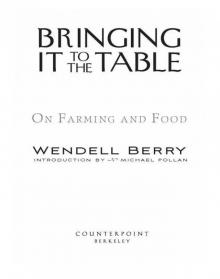 Bringing It to the Table: On Farming and Food
Bringing It to the Table: On Farming and Food Hannah Coulter
Hannah Coulter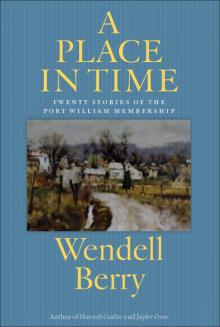 A Place in Time: Twenty Stories of the Port William Membership
A Place in Time: Twenty Stories of the Port William Membership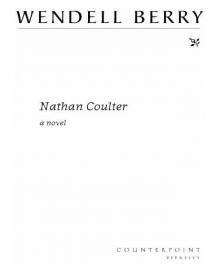 Nathan Coulter
Nathan Coulter Why I Am Not Going to Buy a Computer
Why I Am Not Going to Buy a Computer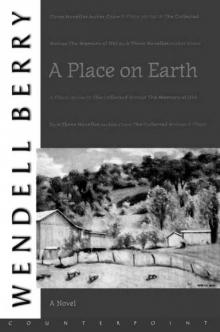 A Place on Earth
A Place on Earth Remembering
Remembering New Collected Poems
New Collected Poems A World Lost
A World Lost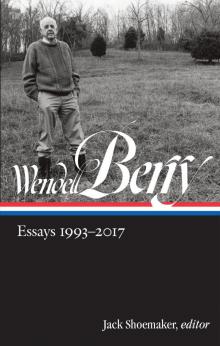 Wendell Berry
Wendell Berry A World Lost: A Novel (Port William)
A World Lost: A Novel (Port William) Fidelity
Fidelity A Place in Time
A Place in Time